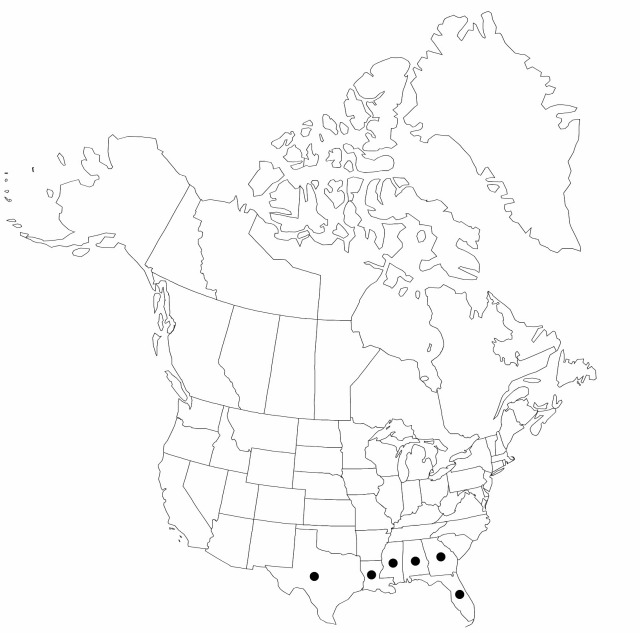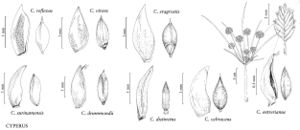Difference between revisions of "Cyperus entrerianus"
Flora 61: 139. 1878.
FNA>Volume Importer |
imported>Volume Importer |
||
| (6 intermediate revisions by 2 users not shown) | |||
| Line 6: | Line 6: | ||
|place=61: 139. 1878 | |place=61: 139. 1878 | ||
|year=1878 | |year=1878 | ||
| + | }} | ||
| + | |special_status={{Treatment/ID/Special_status | ||
| + | |code=I | ||
| + | |label=Introduced | ||
| + | }}{{Treatment/ID/Special_status | ||
| + | |code=F | ||
| + | |label=Illustrated | ||
}} | }} | ||
|basionyms= | |basionyms= | ||
| Line 11: | Line 18: | ||
|name=Cyperus luzulae var. entrerianus | |name=Cyperus luzulae var. entrerianus | ||
|authority=(Boeckeler) Barros | |authority=(Boeckeler) Barros | ||
| + | |rank=variety | ||
}} | }} | ||
|hierarchy=Cyperaceae;Cyperus;Cyperus subg. Pycnostachys;Cyperus entrerianus | |hierarchy=Cyperaceae;Cyperus;Cyperus subg. Pycnostachys;Cyperus entrerianus | ||
| Line 26: | Line 34: | ||
|elevation=0–100 m | |elevation=0–100 m | ||
|distribution=Ala.;Fla.;Ga.;La.;Miss.;Tex.;Mexico;Central America (Nicaragua);South America. | |distribution=Ala.;Fla.;Ga.;La.;Miss.;Tex.;Mexico;Central America (Nicaragua);South America. | ||
| − | |discussion=<p>Cyperus entrerianus is a recent introduction in the southern United States (earliest collection from Pensacola County, Florida, Brinker 413, MO in 1941). It has been confused with C. luzulae. The species that Boeckeler had first described 50 years earlier was accepted by G. Kükenthal (1935–1936). Cyperus entrerianus was accepted as a variety of C. luzulae by A. B. Ayers (1946); M. F. Denton (1978b) considered C. entrerianus a synonym of C. luzulae, stating that the features of these two taxa merged so completely throughout their geographic ranges that C. entrerianus could not be given specific status. Cyperus luzulae in the strict sense does not extend northward to North America.</p><!-- | + | |introduced=true |
| − | --><p>Morphologic differences between Cyperus entrerianus and C. luzulae are as follows (G. C. Tucker 1994). Cyperus entrerianus has culms 40–75 cm; inflorescence bracts ascending at 45–60°; primary rays ascending at 45–60(–75)°; 2d order rays present; heads of spikelets loosely globose-ovoid, light greenish white to golden brown; rachilla dark red with stramineous scale scars; and scale apices acute. Cyperus luzulae has culms 20–40 cm; inflorescence bracts approximately horizontal; primary rays ascending at 15–30°; 2d order rays absent; heads of spikelets densely oblong to pyramidal, bright to dull white; rachilla green throughout; and scale apices rounded.</p> | + | |discussion=<p><i>Cyperus entrerianus</i> is a recent introduction in the southern United States (earliest collection from Pensacola County, Florida, Brinker 413, MO in 1941). It has been confused with C. luzulae. The species that Boeckeler had first described 50 years earlier was accepted by G. Kükenthal (1935–1936). <i>Cyperus entrerianus</i> was accepted as a variety of C. luzulae by A. B. Ayers (1946); M. F. Denton (1978b) considered <i>C. entrerianus</i> a synonym of C. luzulae, stating that the features of these two taxa merged so completely throughout their geographic ranges that <i>C. entrerianus</i> could not be given specific status. <i>Cyperus</i> luzulae in the strict sense does not extend northward to North America.</p><!-- |
| + | --><p>Morphologic differences between <i>Cyperus entrerianus</i> and C. luzulae are as follows (G. C. Tucker 1994). <i>Cyperus entrerianus</i> has culms 40–75 cm; inflorescence bracts ascending at 45–60°; primary rays ascending at 45–60(–75)°; 2d order rays present; heads of spikelets loosely globose-ovoid, light greenish white to golden brown; rachilla dark red with stramineous scale scars; and scale apices acute. <i>Cyperus</i> luzulae has culms 20–40 cm; inflorescence bracts approximately horizontal; primary rays ascending at 15–30°; 2d order rays absent; heads of spikelets densely oblong to pyramidal, bright to dull white; rachilla green throughout; and scale apices rounded.</p> | ||
|tables= | |tables= | ||
|references= | |references= | ||
| Line 36: | Line 45: | ||
-->{{#Taxon: | -->{{#Taxon: | ||
name=Cyperus entrerianus | name=Cyperus entrerianus | ||
| − | |||
|authority=Boeckeler | |authority=Boeckeler | ||
|rank=species | |rank=species | ||
| Line 51: | Line 59: | ||
|publication title=Flora | |publication title=Flora | ||
|publication year=1878 | |publication year=1878 | ||
| − | |special status= | + | |special status=Introduced;Illustrated |
| − | |source xml=https:// | + | |source xml=https://bitbucket.org/aafc-mbb/fna-data-curation/src/2e0870ddd59836b60bcf96646a41e87ea5a5943a/coarse_grained_fna_xml/V23/V23_241.xml |
|genus=Cyperus | |genus=Cyperus | ||
|subgenus=Cyperus subg. Pycnostachys | |subgenus=Cyperus subg. Pycnostachys | ||
Latest revision as of 21:39, 5 November 2020
Herbs, perennial, coarse; rhizomes (seldom collected) indurate, oblique, 5–12 mm wide, with fibrous brown floral scales, 1–5 cm. Culms 1–3, trigonous to roundly trigonous, (30–)40–65(–95) cm × (1–)2–3 mm. Leaves (1–)5–10, V-shaped, (10–)30–45(–70) cm × 3–7 mm. Inflorescences: heads loosely to densely globose-ovoid, (6–)10–12(–20) mm diam.; rays 6–10(–12), 1–8(–12) cm; 2d order rays 1–4, 5–15(–23) mm; bracts (5–)6–8(–10), ascending at 45–60(–75)°, V-shaped, (5–)15–40(–55) cm × (1–)3–7 mm. Spikelets (1–)30–50(–65), greenish white, linear to broadly ellipsoid, flattened, 4–6.5 × 1.8–3.2 mm; floral scales (10–)16–20(–26), laterally clear, pale green, off-white, or light brown, medially green or light brown, laterally weakly 1-ribbed, medially 2-ribbed, basally 2-keeled, oblong-lanceolate, (1.2–)1.4–1.6(–1.8) × (0.7–)0.8–1 mm, apex acute, mucronate, distally glabrous or scabridulous. Flowers: stamen 1; anthers ellipsoid, 0.6–0.7 mm, connective apex acute, 0.1–0.2 mm; styles 0.2–0.4 mm; stigmas 0.4–0.6 mm. Achenes brown, stipitate, ellipsoid to narrowly ellipsoid, broadly rounded or contracted basally, gradually tapered toward apex, 0.9–1.1 × 0.3–0.4 mm, stipe 0.1 mm, apex acute, surfaces finely reticulate.
Phenology: Fruiting summer.
Habitat: Roadside ditches, marshes
Elevation: 0–100 m
Distribution

Introduced; Ala., Fla., Ga., La., Miss., Tex., Mexico, Central America (Nicaragua), South America.
Discussion
Cyperus entrerianus is a recent introduction in the southern United States (earliest collection from Pensacola County, Florida, Brinker 413, MO in 1941). It has been confused with C. luzulae. The species that Boeckeler had first described 50 years earlier was accepted by G. Kükenthal (1935–1936). Cyperus entrerianus was accepted as a variety of C. luzulae by A. B. Ayers (1946); M. F. Denton (1978b) considered C. entrerianus a synonym of C. luzulae, stating that the features of these two taxa merged so completely throughout their geographic ranges that C. entrerianus could not be given specific status. Cyperus luzulae in the strict sense does not extend northward to North America.
Morphologic differences between Cyperus entrerianus and C. luzulae are as follows (G. C. Tucker 1994). Cyperus entrerianus has culms 40–75 cm; inflorescence bracts ascending at 45–60°; primary rays ascending at 45–60(–75)°; 2d order rays present; heads of spikelets loosely globose-ovoid, light greenish white to golden brown; rachilla dark red with stramineous scale scars; and scale apices acute. Cyperus luzulae has culms 20–40 cm; inflorescence bracts approximately horizontal; primary rays ascending at 15–30°; 2d order rays absent; heads of spikelets densely oblong to pyramidal, bright to dull white; rachilla green throughout; and scale apices rounded.
Selected References
None.
